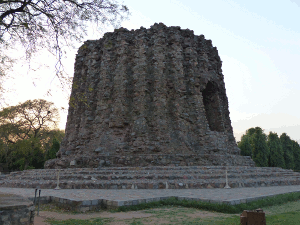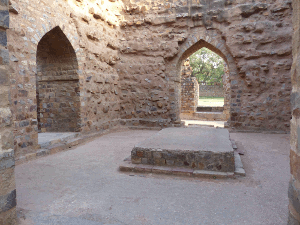The breathtakingly conceived mammoth structure, simply left abandoned was like an extraordinary piece of an epic verse composed with soul stirring passion but never neared completion. Incomplete compositions have an aura of their own because whatever is completed is comprehensible but what is incomplete throws up infinite possibilities and it is uncertainty that is characteristic of the universe of creativity. The courage to dream of constructing something that would stretch to the skies and dwarf everything that was built till then is an astounding indication of the confidence and ambition of the man who dared to dream so. Like the raw beauty who does not dazzle with decoration but instead haunts with her intense looks, the "Alai Minar" continues to haunt me.
 |
| 'Alai Minar': The haunting raw beauty in the sunset |
The incomplete rubble which is 24.5m high is only the core of the first floor, whereas the completed Qutb Minar is five-storied at a height of 72.5m.
The diameter of the base is double that of the Qutb Minar and the Alai Minar was planned to be twice as high as the Qutb!! To stand in front of it and to imagine the completed structure in place of what actually exists would be a challenge to the ability of how far we can comprehend gigantic imaginations. What miracle had its creator Ala-ud-din Khilji envisioned! That it is located within the same complex as the Qutb Minar at simply a sneezing distance from it, gives us a relative picture of what an epic it could have been if completed. Very reminiscent of the Ghaliban phrase "yun hota to kya hota?"
Consolidating the supremacy of the Delhi sultanate over larger parts of North India and extending into the Deccan plateau, Ala-ud-din Khilji left an indelible mark in Indian history. One of the few rulers in the world to have repeatedly defended against the invasions of the Mongol Empire, Khilji is painted in history as brave, ambitious and courageous. Literature has embraced the episode of Chitoor and the legend of Padmavati, where more or less Khilji is a personification of desire and lust. Beyond the descriptions of history and literature, the man has left for posterity his architectural signature, the sheer scale of which is Herculean. An undisputed emperor once, he now lies dead in his tomb, whose roof has fallen long ago. And the tomb is no grandeur but another incomplete structure whose walls are left undecorated, never finished as if left to the mercy of time.
Consolidating the supremacy of the Delhi sultanate over larger parts of North India and extending into the Deccan plateau, Ala-ud-din Khilji left an indelible mark in Indian history. One of the few rulers in the world to have repeatedly defended against the invasions of the Mongol Empire, Khilji is painted in history as brave, ambitious and courageous. Literature has embraced the episode of Chitoor and the legend of Padmavati, where more or less Khilji is a personification of desire and lust. Beyond the descriptions of history and literature, the man has left for posterity his architectural signature, the sheer scale of which is Herculean. An undisputed emperor once, he now lies dead in his tomb, whose roof has fallen long ago. And the tomb is no grandeur but another incomplete structure whose walls are left undecorated, never finished as if left to the mercy of time.
 |
| Ala-ud-din Khilji's tomb |
Rabindranath Tagore in his poem on Shah Jahan and the Taj Mahal, says
"You knew, Emperor of India, Shah-Jahan,
That life, youth, wealth, renown
Float away down the stream of time.
Your only dream
Was to preserve forever your heart's pain."
That life, youth, wealth, renown
Float away down the stream of time.
Your only dream
Was to preserve forever your heart's pain."
But what was it that Khilji was working towards preserving? About five hundred years prior to Shah Jahan, did Khilji actually realise 'That life, youth, wealth, renown Float away down the stream of time'? The 'Alai-Minar' was supposedly his symbol of victory over the Deccan. What irony that the symbol which had to stand for the victory of the emperor stands today as a reminder of the changing times, the changing fortunes and the grand refusal of time to freeze at the foot of any mortal however strong.
Frequently quoted as an example for the failure of over ambition, the Alai Minar incites various emotions. The inner core devoid of ornamental calligraphic work, left uncovered exposing the rough cuts, the unpolished mortar work - is it a reflection of the raw animal spirit that is inherent in each of us? Is it a reflection of how we all are crude in our core and all our appeasing outer appearance is simply a mask of transient beauty? Is it a reminder that behind every polished work of enchanting beauty lies an unpolished rough reality? Is it a time ordained message that beauty, grandeur, greatness, perfection, excellence are all patchworks masking human frailty, failure, raw reality, harshness, imperfection?
Though the importance of a work of art is measured on the basis of its historical significance, contemporary relevance, cultural contribution among other things, a primordial measure is how many ripples of thought does it give birth to in the thinking mind. Pablo Picasso famously said "Art is a lie that helps us see the truth." Since this colossal structure triggers the thought of many truths, at least to me on a personal level, it is an extraordinary marvelous work of art. It has left me mesmerized. It has left me with a lot of questions. It has left me with a haunting feel of incompletion. It has left me with a yearning for the infinite. It has left me with thoughts of naught, from which all that exists is born.
Though the importance of a work of art is measured on the basis of its historical significance, contemporary relevance, cultural contribution among other things, a primordial measure is how many ripples of thought does it give birth to in the thinking mind. Pablo Picasso famously said "Art is a lie that helps us see the truth." Since this colossal structure triggers the thought of many truths, at least to me on a personal level, it is an extraordinary marvelous work of art. It has left me mesmerized. It has left me with a lot of questions. It has left me with a haunting feel of incompletion. It has left me with a yearning for the infinite. It has left me with thoughts of naught, from which all that exists is born.
No comments:
Post a Comment